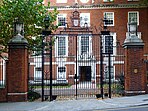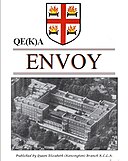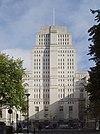Queen Elizabeth College
 Arms of Queen Elizabeth College | |
Former names | KCHSS |
|---|---|
| Type | Public |
| Active | 1953–1985 |
| Location | , |
| Campus | Urban |
| Colours | Red and Gold |
| Nickname | QEC |
| Affiliations | University of London |
| Website | www |
 | |
| Merged with King's College London | |
Queen Elizabeth College (QEC) had its origins in the Ladies' (later Women's) Department of King's College, London, England, opened in 1885. The first King's 'extension' lectures for ladies were held at Richmond in 1871, and from 1878 in Kensington, with chaperones in attendance.
In 1881, the Council resolved 'to establish a department of King's College, London, for the higher education of women, to be conducted on the same principles as the existing departments of education at this college'. By 1886, the King's College, London Ladies' Department had 500 students. In 1902 it became the King's College, London Women's Department and in 1908 King's College for Women. In 1907 lectures were given in subjects then thought to be specially relevant to women, such as 'the economics of health' and 'women and the land', and in 1908 systematic instruction in household and social sciences began.[1]
In 1915, the Household and Social Science Department of King's College for Women opened at Campden Hill Road, Kensington, while other departments were transferred to the Strand site. In 1928 the Department became completely independent as King's College of Household and Social Science, and in 1953 it received a royal charter, its name was changed to Queen Elizabeth College and men were admitted for the first time. The College became distinguished for its teaching and research in nutrition, physiology, hygiene and microbiology. It was recognised as a School of the University of London in 1956.
The original Campden Hill Road buildings combined both the lecture theatres, laboratories and library but also included the only Hall of residence - Queen Mary Hall. By the late 1960s the expansion of student numbers and the need for additional laboratory capacity necessitated the construction of a new Building - the Atkins building [1] located on Campden Hill, behind the main college.
Merger with King's College London

QEC re-merged with King's College London in 1985,[1] and the Kensington campus became associated with biomedical sciences. However, the campus was closed and sold in 2000 with the contents being decanted to the Franklin-Wilkins Building. Part of the campus has subsequently been converted into Academy Gardens, apartments which retain some QEC branding.
College newsletter

Envoy is the annual newsletter of Queen Elizabeth College.[2] The Queen Elizabeth College alumni/old student association organizes a reunion every year.[3][4][5]
Academic staff
- John Yudkin, physiologist and nutritionist
- Garth Chapman, academic, author and zoologist
- William B. Bonnor, mathematician and gravitation physicist
- Alice Copping, nutritionist
- Christopher Dainty, physicist
- K. Kunaratnam, physicist and academician
Notable alumni

- Radclyffe Hall, poet and author
- Nancy Rothwell, physiologist and academician
- Devendra Prasad Gupta, botanist and academician
- Sheila Rodwell, nutritional epidemiologist
- Joel Mandelstam, microbiologist
- Qui-Lim Choo, co-discoverer of Hepatitis C and of the Hepatitis D genome
- Pegaret Anthony, artist
- Keith Campbell, biologist
References
- ^ a b c King's College London - ·History of QEC
- ^ "QEC's newsletter Envoy". Queen Elizabeth College Old Students Association. Retrieved 5 August 2014.
- ^ "In Touch Spring 2013 : QEC/KCHSS annual reunion". King's College London. p. 32. Retrieved 5 August 2014.
- ^ "Intouch Autumn 2009: The Queen Elizabeth (Kensington) Branch Annual Reunion". King's College London. pp. 30–31. Retrieved 5 August 2014.
- ^ "Special interest : Queen Elizabeth (Kensington) Branch". KCLA King's College London Association. Retrieved 5 August 2014.
External links
- Queen Elizabeth College
- Educational institutions established in 1885
- Education in Kensington and Chelsea
- King's College London
- Former women's universities and colleges in the United Kingdom
- Defunct universities and colleges in London
- Educational institutions disestablished in 1985
- Charles Holden buildings
- Former colleges of the University of London


